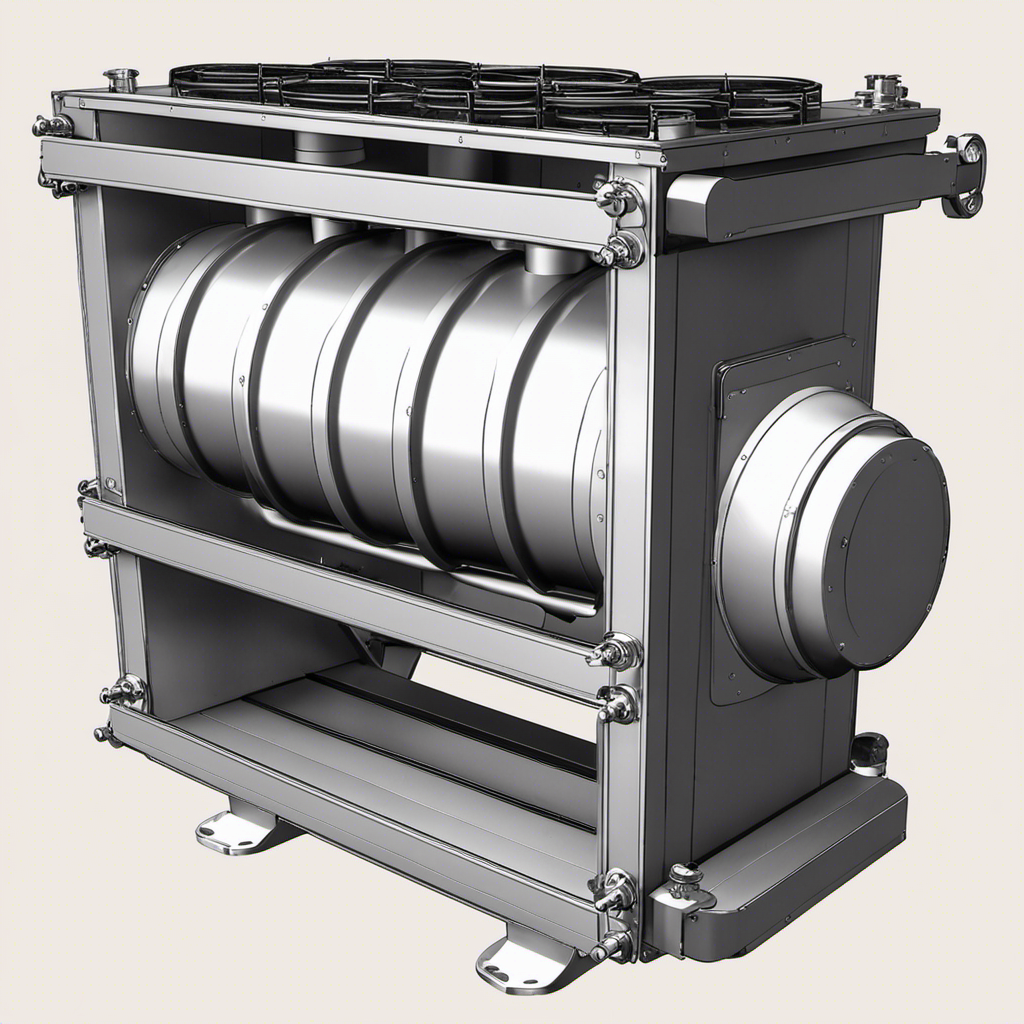Did you know that utilizing a wood-burning stove can reduce your heating expenses by as much as 30%?
In this article, I’ll show you how to work a wood stove safely and efficiently. From gathering firewood to adjusting the damper, I’ll provide you with step-by-step instructions to make the most of your wood stove.
Whether you’re a seasoned wood stove user or a beginner, this guide will ensure that you stay warm and cozy all winter long.
Key Takeaways
- Familiarize yourself with emergency procedures and have a fire extinguisher readily available.
- Keep firewood off the ground, stack it on a raised platform, and cover it to protect it from moisture.
- Start the fire with small pieces of crumpled newspaper and arrange dry kindling sticks on top.
- Control the air intake, regularly clear away ash buildup, and adjust the damper to optimize stove performance.
Safety Precautions
I need to be cautious when using a wood stove to ensure my safety. Wood stoves can provide warmth and comfort, but they also pose certain risks if not handled properly. It’s important to familiarize myself with emergency procedures and ensure proper ventilation to minimize the chances of accidents or health issues.
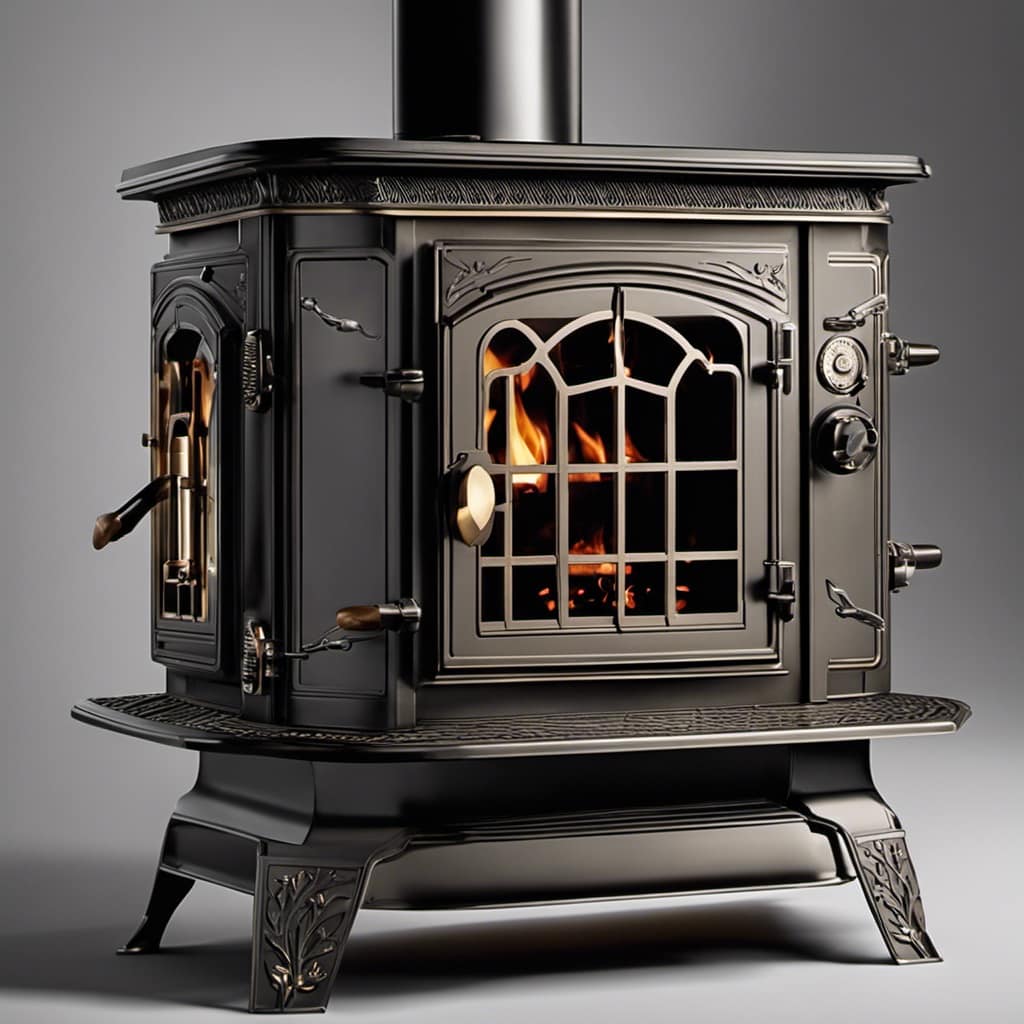
First and foremost, I should have a clear understanding of the emergency procedures related to my wood stove. It’s crucial to have a fire extinguisher readily available and know how to use it in case of a fire. Additionally, I should have a fire escape plan in place and practice it regularly with my family. Being prepared for any potential emergencies will help me respond quickly and effectively.
Proper ventilation is another key aspect of wood stove safety. Ensuring adequate airflow is essential to prevent the buildup of harmful gases, such as carbon monoxide. I should check the chimney regularly for any blockages or obstructions and clean it as needed. It’s also important to open a window slightly when using a wood stove to allow fresh air to enter the room and maintain proper ventilation.
Gathering Firewood
To start a fire in the wood stove, I always make sure to gather enough firewood beforehand. Proper firewood storage is essential to ensure that the wood is dry and ready to burn efficiently. There are different types of firewood, each with its own characteristics and burning properties.
When it comes to firewood storage, it’s crucial to keep the wood off the ground to prevent moisture absorption. I stack my firewood on a raised platform or pallets, allowing air to circulate and promote drying. It’s also important to cover the woodpile with a tarp or waterproof covering to protect it from rain or snow.
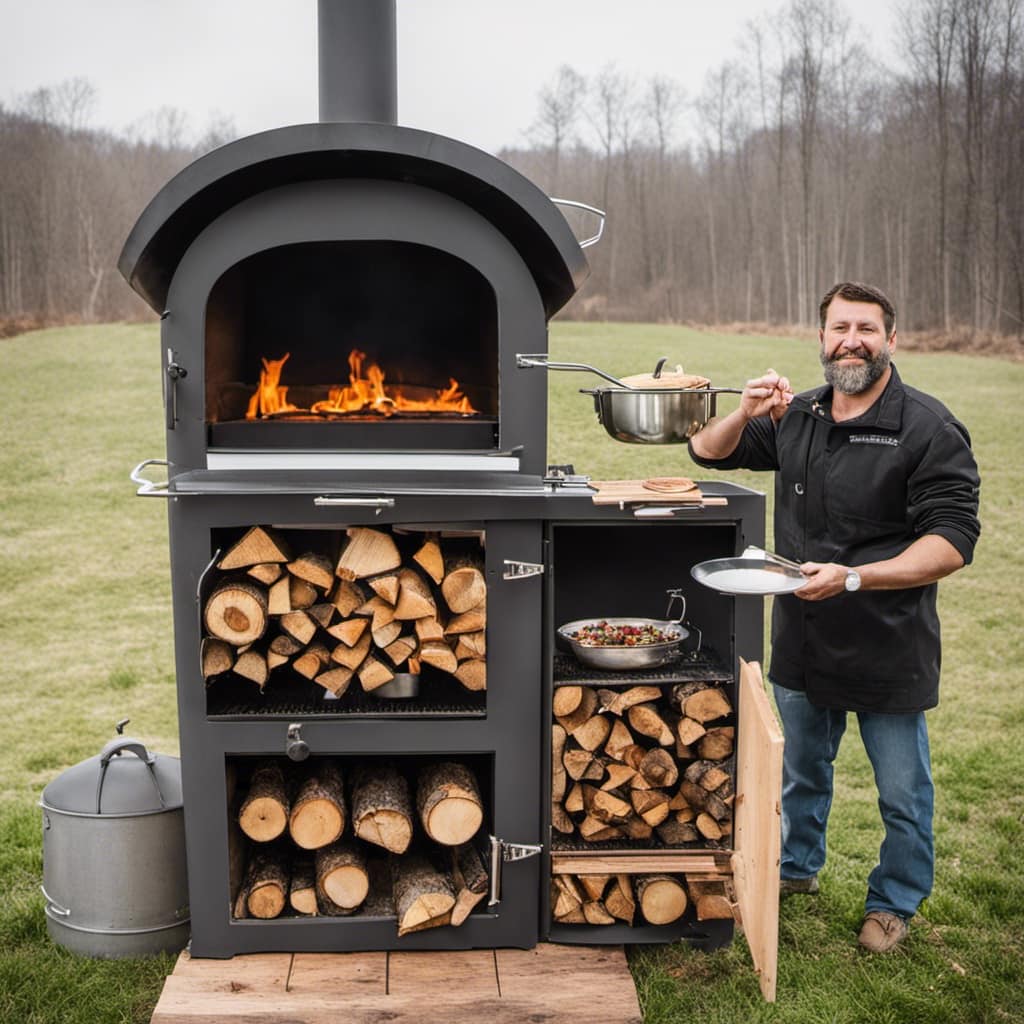
Now, let’s discuss the types of firewood. Hardwoods, such as oak, maple, and birch, are known for their high energy content and long-lasting burn. They produce more heat and create a bed of hot coals, which is ideal for heating your home. Softwoods, like pine and spruce, ignite quickly but burn faster. They’re perfect for kindling and starting a fire, but they may need more frequent refueling.
Building the Fire
A well-built fire starts with placing small pieces of crumpled newspaper at the bottom of the stove. This provides a good base for the fire to catch and spread. Once the newspaper is in place, I carefully arrange small kindling sticks on top. The kindling sticks should be dry and about the thickness of a pencil. They act as fuel to ignite the larger pieces of firewood.
After the kindling is arranged, I select three pieces of firewood from my well-organized firewood storage area. It’s important to choose seasoned firewood that has been properly stored and dried for at least six months. This ensures that the firewood will burn efficiently and produce less smoke. I place the three pieces of firewood on top of the kindling, forming a teepee shape. This allows for proper air circulation and helps the firewood ignite quickly and evenly.
Once everything is in place, I ignite the newspaper at the bottom of the stove using a long match or lighter. The flames from the newspaper quickly catch the kindling, and as the kindling burns, it ignites the firewood. Within a few minutes, a warm and cozy fire begins to glow, providing heat and comfort.

Lighting the Fire
The flames from the newspaper quickly catch the kindling, creating a warm and cozy fire. As I sit by the wood stove, I can’t help but feel a sense of comfort and security. The crackling sound of the firewood and the flickering flames create a mesmerizing ambiance. It’s important to remember, though, that safety should always be a top priority when working with a wood stove. This includes having a fire extinguisher readily available in case of emergencies. It’s also crucial to have a proper firewood storage system in place to ensure the wood is kept dry and ready for use.
To evoke emotion in the audience, I’ve created a table showcasing the benefits of having a fire extinguisher and a firewood storage system:
| Fire Extinguisher | Firewood Storage |
|---|---|
| Provides safety in case of fire emergencies | Keeps firewood dry and ready for use |
| Easy to use and operate | Prevents wood from rotting or getting infested with insects |
| Can quickly extinguish small fires | Organizes firewood and prevents clutter |
| Essential for protecting your home and loved ones | Allows for easy access to firewood during colder months |
| Peace of mind knowing you’re prepared for emergencies | Helps maintain a consistent and efficient fire |
Maintaining the Fire
To maintain the fire in a wood stove, it’s crucial to control the air intake, add fuel properly, and clear ash buildup.
By adjusting the air intake vents, you can regulate the amount of oxygen entering the stove, which affects the burn rate and temperature.
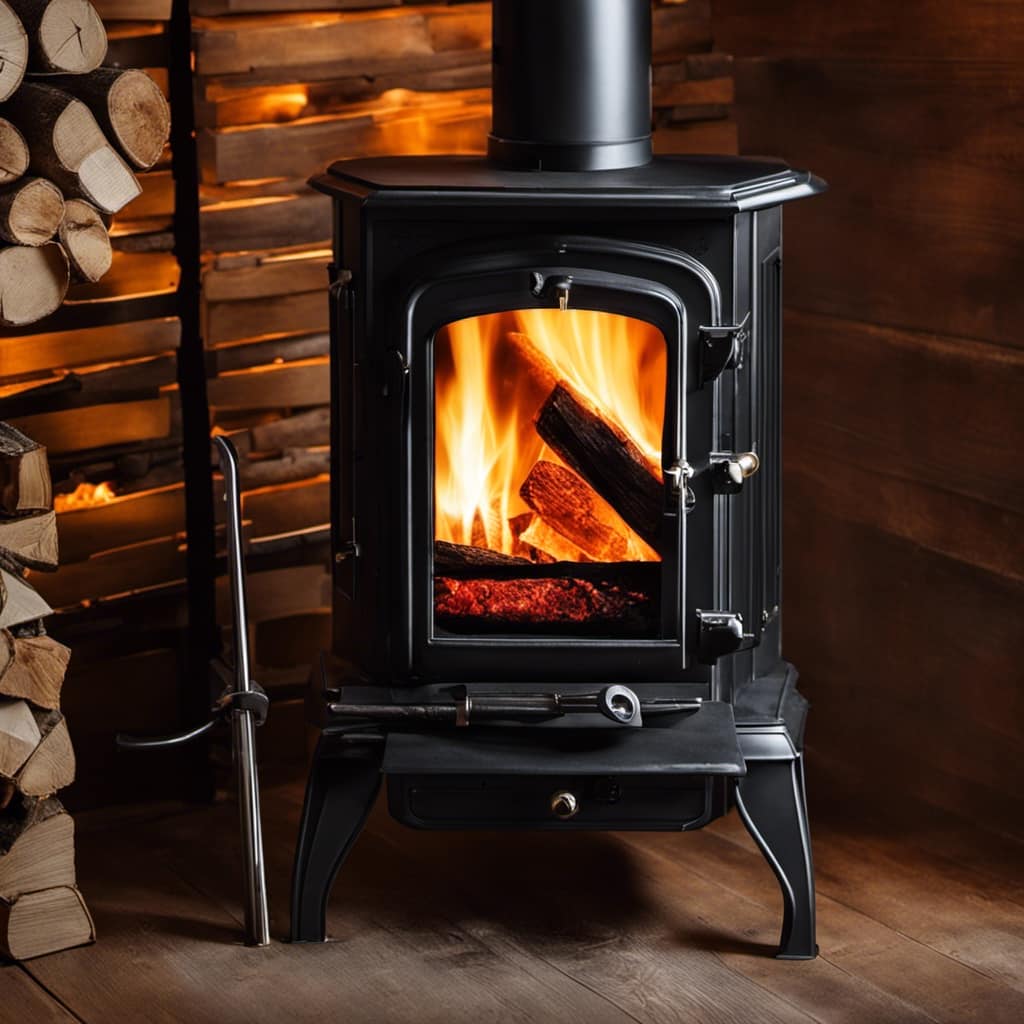
Adding fuel in small increments and allowing it to catch fire fully before adding more helps maintain a steady and efficient burn.
Regularly clearing away ash buildup from the firebox ensures proper airflow and prevents it from smothering the fire.
Controlling Air Intake
I can adjust the air intake to control the temperature of the wood stove. Proper ventilation is crucial for maximizing efficiency and ensuring a safe and effective wood burning experience. By adjusting the air intake, I can regulate the amount of oxygen that reaches the fire, which in turn affects the intensity of the flames and the heat output.
Here are three important things to keep in mind when controlling the air intake:
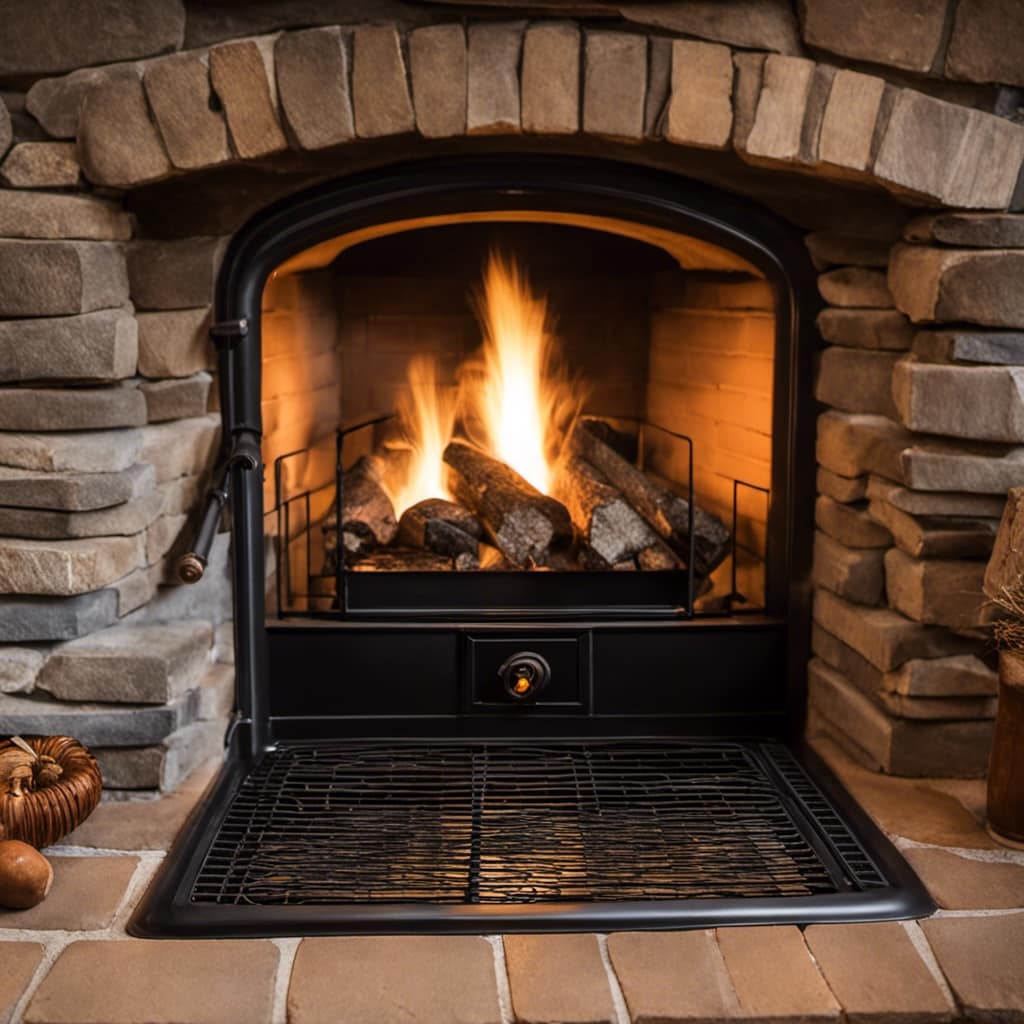
- Opening the air intake fully allows for maximum oxygen supply, resulting in a hotter and more intense fire.
- Closing the air intake partially reduces the oxygen supply, resulting in a slower burn and lower heat output.
- Adjusting the air intake in small increments allows for fine-tuning of the fire’s temperature and intensity.
By understanding how to control the air intake, I can effectively manage the wood stove’s heat output and maintain a comfortable and efficient burn.
Now, let’s move on to the next section: adding fuel properly.
Adding Fuel Properly
When adding fuel, I should make sure to place it evenly and avoid overcrowding the firebox. This ensures efficient burning and helps maintain a steady heat output.
It’s important to choose the right type of firewood for optimal performance. Hardwoods, such as oak or maple, are ideal as they burn longer and produce more heat. Softwoods, like pine or spruce, burn faster and are better for starting the fire.

It’s crucial to properly season the firewood before use, as green or wet wood can lead to incomplete combustion and creosote buildup.
Additionally, the size of the firewood matters. It’s recommended to cut the logs into smaller pieces to ensure they fit properly and allow for proper airflow within the firebox.
Clearing Ash Buildup
Clearing the ash buildup is an important step in maintaining optimal performance and efficiency. Ash buildup can hinder the airflow and reduce the effectiveness of your wood stove. To ensure proper functioning, follow these cleaning techniques:
-
Regularly remove the ash: Use a metal scoop or shovel to scoop out the ash from the stove. Dispose of it in a metal container with a tight-fitting lid to prevent any remaining embers from igniting.
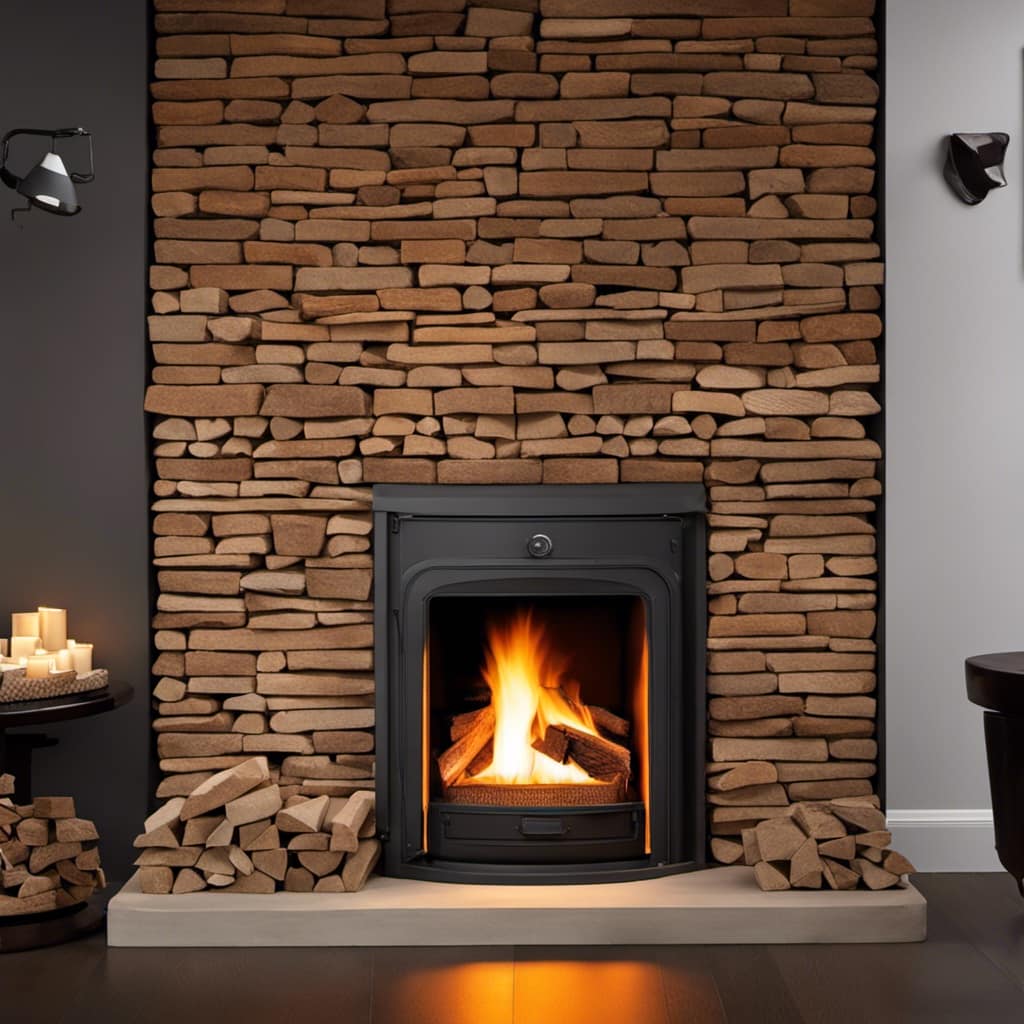
-
Clean the ash pan: The ash pan collects ash that falls through the grate. Empty it regularly to prevent it from overflowing and causing smoke.
-
Check the baffle: The baffle is a plate that directs the flow of smoke and gases. Inspect it for any ash buildup and clean it if necessary to prevent smoke from escaping into the room.
Adjusting the Damper
The damper can be easily adjusted to control the airflow and heat output of the wood stove. By manipulating the damper, you can achieve efficient burning and regulate the temperature inside your wood stove. It is an essential feature that allows you to optimize the performance of your stove and create a comfortable environment in your home.
The damper is typically located on the top or side of the stove and can be opened or closed to control the amount of air flowing into the firebox. When the damper is fully open, more oxygen is supplied to the fire, resulting in a hotter fire and increased heat output. On the other hand, closing the damper restricts the airflow, reducing the intensity of the fire and heat production.
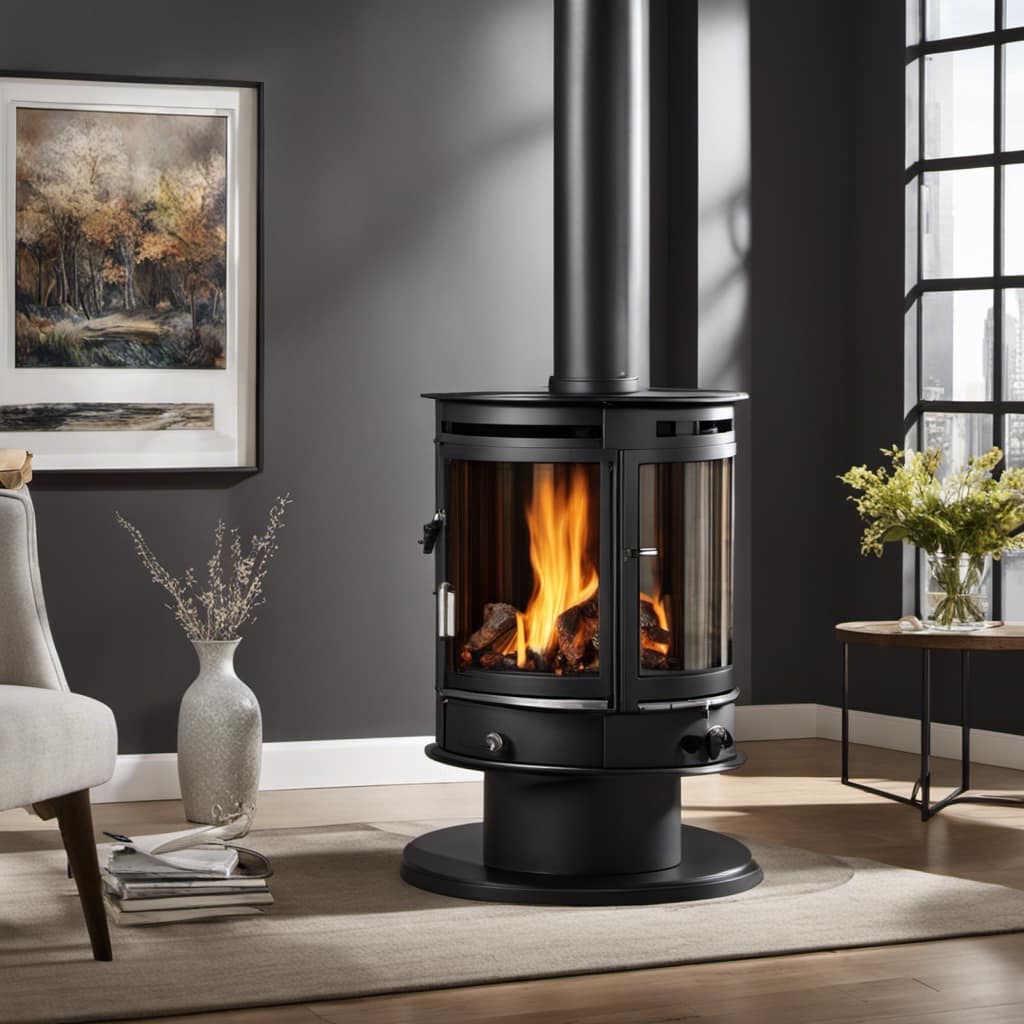
To help you understand the impact of adjusting the damper, here is a table showing the relationship between damper position, airflow, and heat output:
| Damper Position | Airflow | Heat Output |
|---|---|---|
| Fully Open | High | High |
| Partially Open | Moderate | Moderate |
| Closed | Low | Low |
Frequently Asked Questions
Can I Leave My Wood Stove Unattended While It’s Burning?
Yes, you can leave your wood stove unattended while it’s burning, but it’s important to follow proper wood stove safety guidelines.
Before leaving, make sure the fire is contained within the stove and that the stove is functioning properly.
Keep flammable materials away from the stove and ensure proper ventilation.
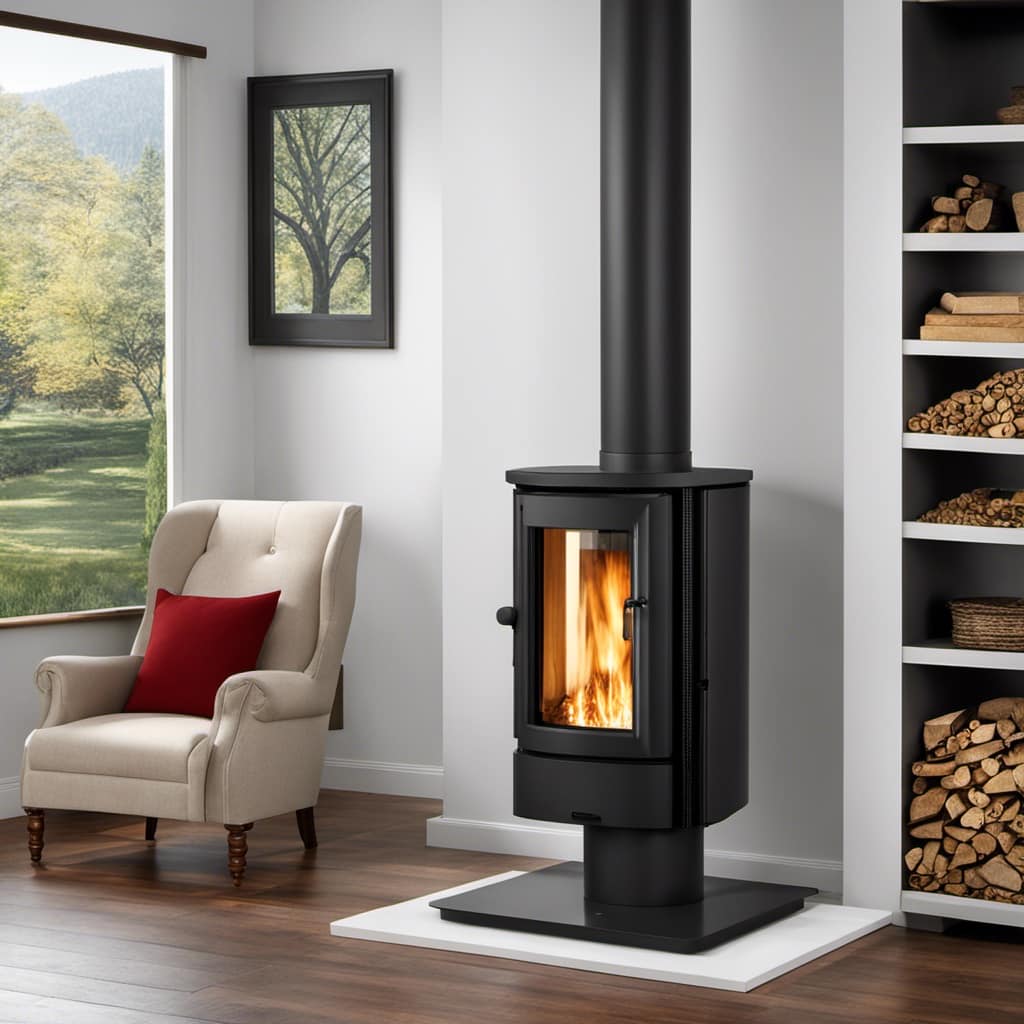
Regular wood stove maintenance is also crucial to ensure optimal safety.
It’s recommended to have your stove inspected and cleaned annually by a professional.
How Often Should I Clean My Wood Stove?
Maintaining a wood stove is crucial for its longevity and efficiency. When it comes to cleaning, frequency is key. Regularly removing ash and creosote buildup from the stove’s interior and chimney ensures optimal performance and reduces the risk of chimney fires.
The exact cleaning schedule depends on usage, but a general guideline is to clean the stove at least once a month during the heating season. However, it’s always best to consult the manufacturer’s recommendations for your specific wood stove model.

Can I Burn Trash or Paper in My Wood Stove?
Burning trash or paper in a wood stove isn’t recommended due to burning regulations and safety concerns.
It’s important to follow proper guidelines when using a wood stove to prevent fires and protect the environment.
Instead, consider alternative fuel sources such as dry firewood or wood pellets that are specifically designed for use in wood stoves.
These alternative fuels provide efficient and clean burning, ensuring the longevity and performance of your wood stove.
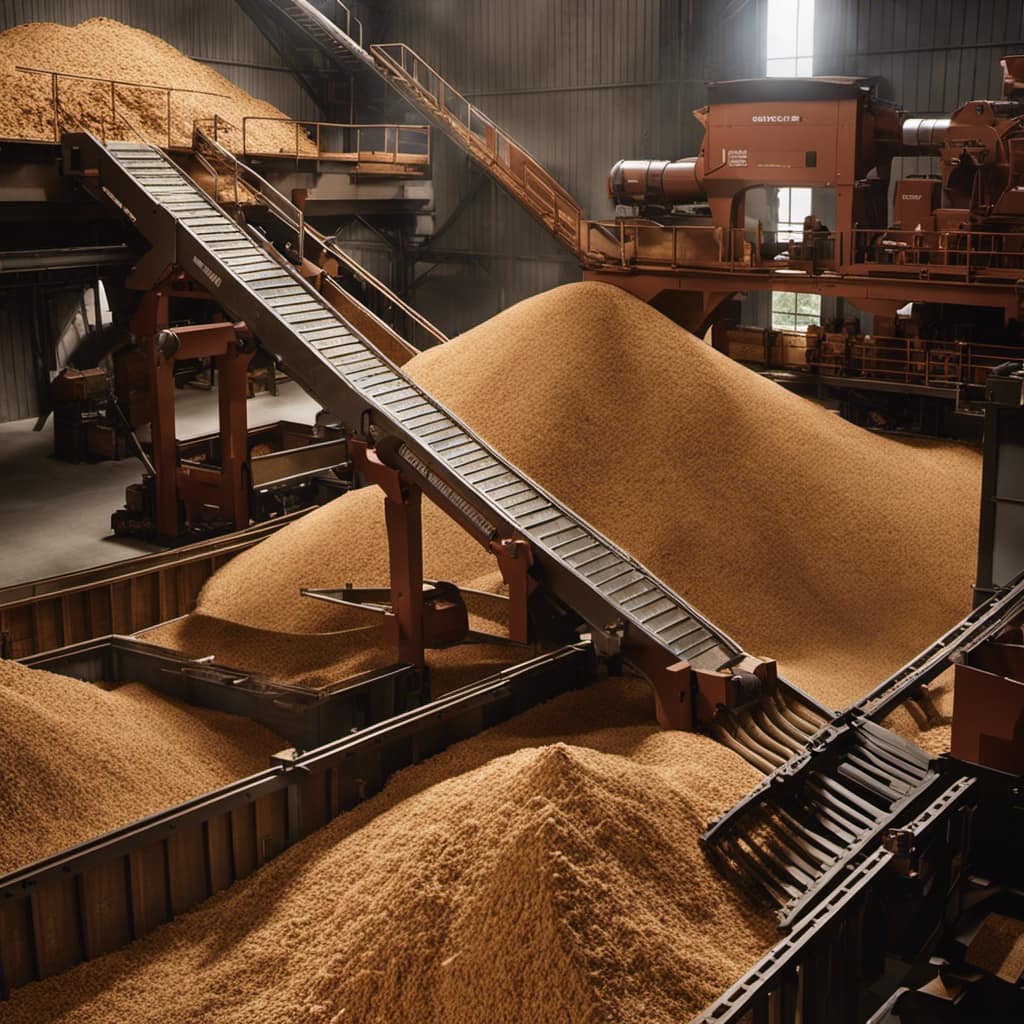
What Should I Do if My Wood Stove Is Producing Excessive Smoke?
If my wood stove is producing excessive smoke, there are a few troubleshooting tips I can try.
First, I should check if the firewood is properly seasoned and dry. Wet or unseasoned wood can lead to poor combustion and more smoke.
Next, I should ensure that the air vents are open and adjusted correctly to allow for proper airflow.
Lastly, I should inspect the chimney for any blockages or buildup that could be affecting the stove’s performance.
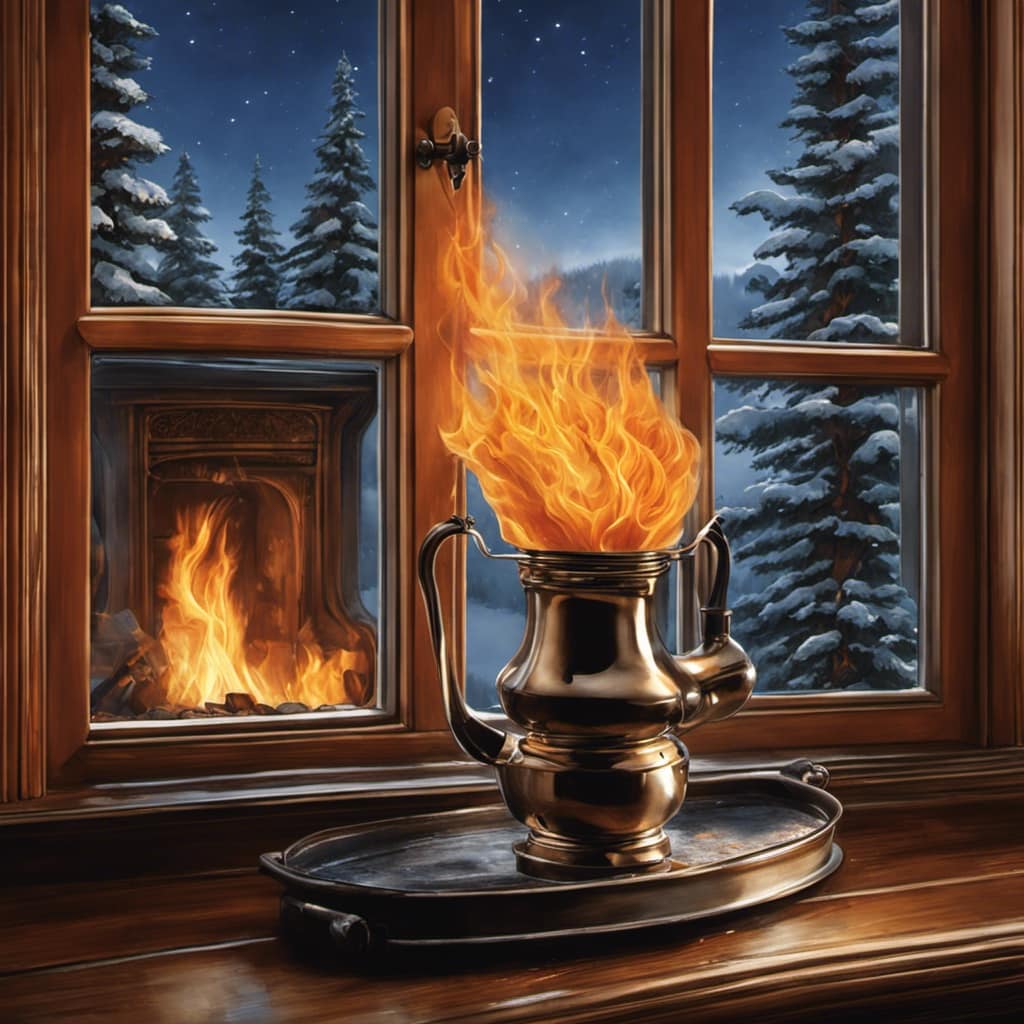
Is It Safe to Install a Wood Stove on a Second Floor of a House?
Installing a wood stove on the second floor of a house may not be the safest idea. The weight and heat generated by the stove could potentially compromise the structural integrity of the floor.
Additionally, the risk of fire increases when a wood stove is installed on an upper level.
It’s crucial to prioritize safety and consult with professionals before making any decisions.
Conclusion
In conclusion, working a wood stove requires safety precautions, gathering firewood, building and lighting the fire, and maintaining it throughout the day.
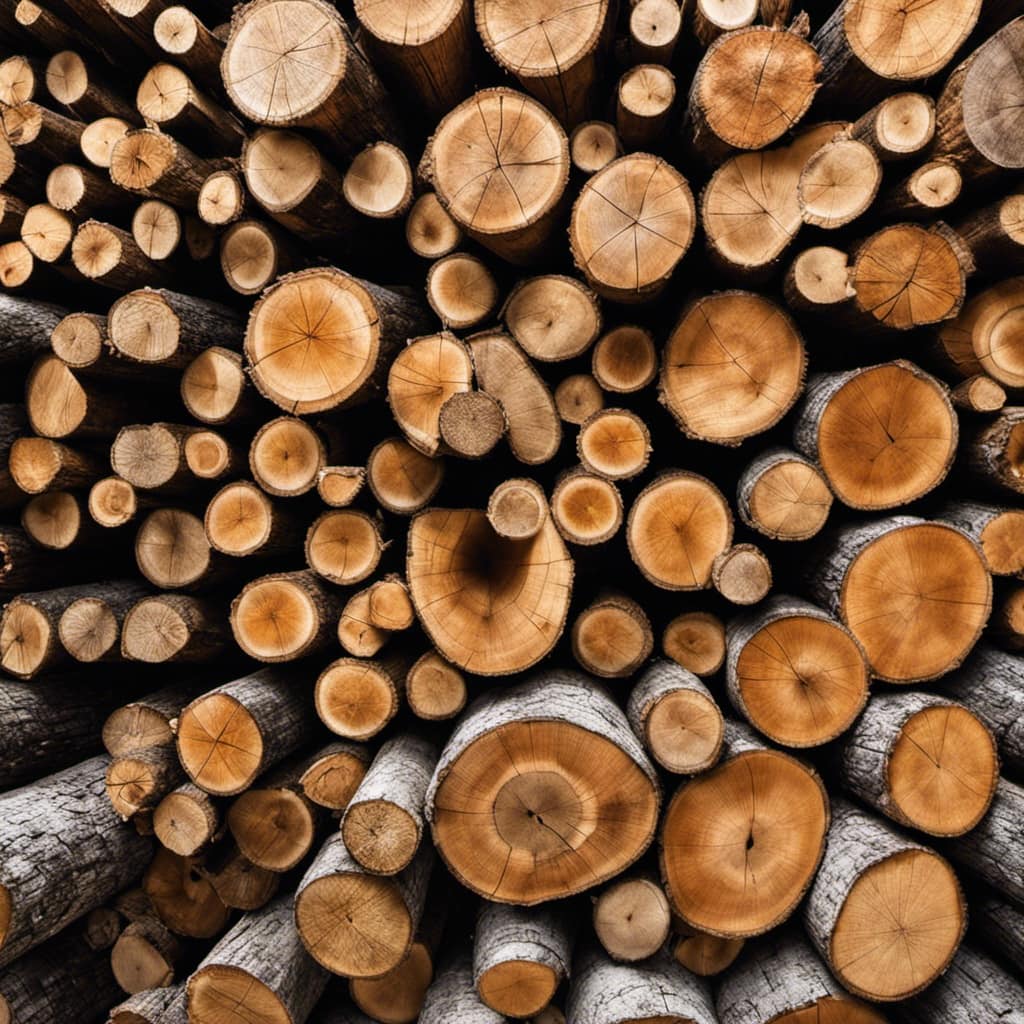
Adjusting the damper is also crucial for controlling the airflow and heat output.
Remember, practicing proper safety measures and following these detailed instructions will ensure a successful and efficient wood stove experience.
So, stay safe, gather your firewood, and enjoy the warmth of your wood stove while embracing the alluring aroma of crackling flames.
Growing up surrounded by the vast beauty of nature, Sierra was always drawn to the call of the wild. While others sought the comfort of the familiar, she ventured out, embracing the unpredictable and finding stories in the heartbeat of nature.
At the epicenter of every remarkable venture lies a dynamic team—a fusion of diverse talents, visions, and passions. The essence of Best Small Wood Stoves is crafted and refined by such a trio: Sierra, Logan, and Terra. Their collective expertise has transformed the platform into a leading authority on small wood stoves, radiating warmth and knowledge in equal measure.






